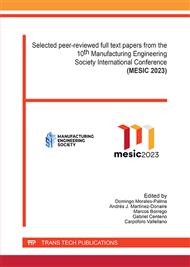p.3
p.13
p.22
p.31
p.43
p.53
p.61
p.70
Mathematical Optimization of Cold Wire Drawing Operations
Abstract:
An analytical model of the cold wire drawing process is used to implement an optimization procedure. The optimization aims to minimize the number of passes required to achieve a given reduction while maintaining a safe value of the drawing stress in each step. The number of passes and the sequence of intermediate diameters are the output of the optimization model. The sequence of diameters is optimal in the sense that minimizes a mathematical objective function, and their values must be considered a first attempt to determine appropriate values for a specific wire drawing operation. With respect to prior contributions, the work hardening of the material is exploited to reduce the number of passes. The reduction of the number of passes yields lower values of the aspect ratio, defined as the mean diameter divided by the contact length, which is an important factor to prevent the onset of internal defects. The optimization is performed numerically with mathematical programming and metaheuristic algorithms.
Info:
Periodical:
Pages:
13-21
Citation:
Online since:
October 2023
Price:
Сopyright:
© 2023 Trans Tech Publications Ltd. All Rights Reserved
Share:
Citation:



